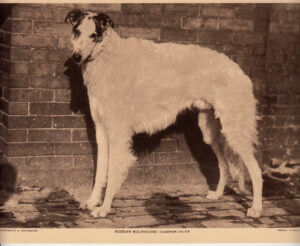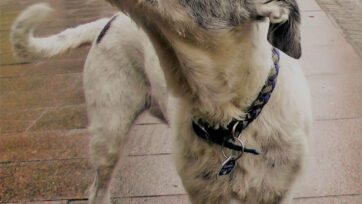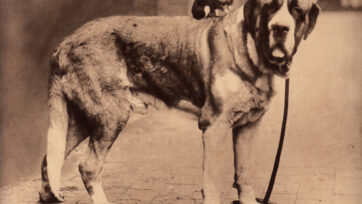UNDERSTANDING CANINE COGNITIVE DISORDER
When we talk about canine cognitive disorder, another name would be Alzheimer’s disease because it’s very much like it. Even though the conditions are not identical, the effects are very similar. This disorder impacts dogs later in their life and usually comes on slowly and silently. The brain deteriorates with age just as the rest of the body does in humans and dogs. Sometimes the deterioration causes changes in the physical and chemical makeup of the brain, resulting in a decrease in your dog’s cognitive functions.
So just what is “cognitive function”? It is all of the mental processes, such as perception, memory, awareness, and judgment. Cognitive dysfunction is sometimes described as a “foggy brain”-a state in which normal, everyday functions are no longer simple.
Every single dog is at risk of canine cognitive disorder ( CDD ), and all dogs are affected differently.
Here Are Some Of The Common Signs Of CCD:
- Behavior changes
- Reduced ability to see, hear, or taste
- Having trouble moving around familiar environments
- Confusion or disorientation
- Staring off into space
- Loss of housebreaking skills
- Constant barking
- Obsessive behaviors ( licking, barking, etc. )
- Anxiety
- Can’t recognize familiar objects or people
- Altered sleeping and waking cycles
- Reduced interest in food or family
What Can You Do?
Sadly, there isn’t any single diagnostic test for CCD. Your veterinarian will perform a complete physical and neurological examination and take a thorough history of your dog. They will most often recommend diagnostic tests to confirm the cause of his symptoms. These diagnostic tests also serve as a preventive care screening, which may help in detecting other diseases in their early stages that might have similar signs.
The Diagnostic Tests May Include:
Chemistry tests for evaluation of Kidney, liver, and pancreatic function, as well as sugar levels.
Blood tests to identify if your pet has been exposed to tick-borne or other infectious diseases.
A complete blood count to rule out blood – related conditions.
Testing electrolytes to ensure your dog isn’t dehydrated or suffering from an electrolyte imbalance.
Urine testing to screen for urinary tract infection and other diseases, and to evaluate the ability of the kidneys to concentrate urine.
A thyroid test to determine if the thyroid gland is producing too little thyroid hormone.
An ECG to screen for an abnormal heart rhythm, which may indicate underlying heart disease; or blood tests such as Cardiopet proBNP to assess heart health.
IS THERE A TREATMENT?
No, there isn’t any cure for this disorder, but it can be treated to slow the progression or improve signs. Drug therapy is a very popular way to treat canine cognitive dysfunction. The drugs take time to have an effect but may help to improve your dog’s cognitive function and increase her comfort level. Other helpful steps can include antioxidant treatments, mental stimulation, and lifestyle modifications.
THE PAIN OF HIP DYSPLASIA IN DOGS
So just what is it, hip dysplasia is a condition resulting from an improperly formed hip joint that becomes loose. The dog’s leg bone then moves around too much, causing painful wear and tear.
SOME SIGNS THAT YOUR DOG HAS HIP DYSPLASIA
There are some cases of hip dysplasia that are so mild that the symptoms aren’t readily seen, but if your dog seems stiff or sore in the hips when getting up, and if he seems hesitant to exercise, stand on his hind legs or climb stairs, is limping or bunny-hopping, you should visit your vet. to find out if hip dysplasia is the cause.
WHEN DOES HIP DYSPLASIA START TO DEVELOP
All cases are different and depend on the dog. Hip dysplasia can begin to develop in puppies of five months old and get worse as they age or not show up at all until the dog reaches his geriatric years. In many cases, though, the condition becomes noticeable in dogs in their middle or later years.
HOW IS HIP DYSPLASIA DIAGNOSED?
An evaluation for hip dysplasia will include a physical examination, radiographs, and manual tests on your dog’s hips
ARE CERTAIN DOGS PRONE TO HIP DYSPLASIA?
There are certain breeds of larger dogs that are commonly affected by hip dysplasia, including bulldogs, mastiffs, American Staffordshire terriers, St. Bernards, retrievers, and Rottweilers. However, dogs of all breeds and sizes are susceptible to this inherited condition, including some small breeds, such as pugs, and French bulldogs.
WHAT ARE THE TREATMENTS FOR HIP DYSPLASIA?
Because hip dysplasia is caused by an inherited genetic defect, there are no products that can prevent its development. There are several surgical options, which included a complete hip replacement. However, a combination of a healthy diet, maintaining a normal weight, exercise, massage, warm and dry sleeping areas, joint supplements, and, potentially, prescription veterinary pain-relieving medications can help manage the condition. Your vet. will help you with a daily pain-relieving program that is right for your dog.
SHOULD DOGS WITH HIP DYSPLASIA EXERCISE?
Exercising your dog with hip dysplasia should be discussed with your vet. Walking and moderate running can help strengthen the muscles around the joint. Your vet. may recommend that you try for two 20-minute walks each day-just to be sure to let your dog set the pace. As a general rule. it’s best to avoid jumping or running for long distances. If you can, consider letting your dog do some swimming which is excellent for the muscles surrounding the joints.
WILL A PROPER DIET HELP ALLEVIATE SYMPTOMS OF HIP DYSPLASIA?
Weight plays an important role in the comfort of your dog’s hips. Extra weight can add undue stress to hip joints, so make sure your dog is on a healthy diet, especially if he’s a large breed. You can work with your vet. to find the right eating program for your dog.
OTHER THINGS YOU CAN DO TO EASE THE PAIN
Discuss with your vet. if these tips might help:
- Apply a warm water bottle for 15 minutes twice a day.
- Massage the muscles around his hip joints, gently rubbing in a circular motion with your fingertips for ten minutes at the most. ( Pay attention to his response. If massage seems to irritate your dog’s hip, don’t continue. )
- There are prescription painkillers available from your veterinarian to help keep your dog pain-free.
- Keep your dog out of damp, chilly weather.
- Provide traction on slippery floors: Dogs with hip dysplasia can have a hard time on slippery floors, laying down carpet can help, and if he needs to climb stairs or jump up into the car, a carpeted ramp will make it a lot easier.
- Provide a firm, orthopedic bed for your dog.
MORE ON HIP DYSPLASIA
Hip dysplasia in canines is a skeletal condition, most common in large or giant dog breeds, although this can occur in all breeds of dog. A basic understanding of how the hip joint functions as a ball and socket is key to understanding how the disease works.
Dogs with hip dysplasia have a ball and socket that does not properly fit or develop properly, rubbing and grinding instead of sliding smoothly. This results in deterioration over time and an eventual loss of function of the joint itself.
Genetics is one factor in the beginning of hip dysplasia in large dogs. Hip dysplasia is hereditary and large or giant dogs such as, Great Danes, Saint Bernards, Labrador Retrievers, and German Shepherds are most likely to develop it. Factors such as excessive growth rate, types of exercise, and improper weight and nutrition can magnify this genetic predisposition.
Puppies of large or giant dog breeds have special nutrition requirements and need specially formulated for large breed puppies. These foods help prevent excessive growth, which can lead to skeletal disorders like hip dysplasia, along with elbow dysplasia and other joint conditions. Slowing down these breeds’ growth rate allows their joints to develop without putting too much strain on them, helping to prevent problems down the line.
The wrong kind of diet can also influence a dog’s likelihood of developing hip dysplasia, and so can too much exercise – or too little. Obesity also puts a lot of stress on the dog’s joints, which can exacerbate a pre-existing condition such as hip dysplasia and even cause it. Consult your vet about the best diet for your dog and the right amount of exercise that is best for him so stay in good physical condition.
Small dog owners are not immune to this disease either. Small and medium dog breeds can also develop hip dysplasia, even though it is less common.
LARGE DOGS NEED GLUCOSAMINE
Large and giant dog breed foods often contain joint supplements like glucosamine. If your veterinarian diagnoses your dog with arthritis, glucosamine will most likely be a part of a comprehensive treatment plan. Most likely a chewable, veterinarian grade dose of glucosamine, chondroitin, and MSM will be recommended.
Additional supplements, such as NturVet’s ArthriSoothe-Gold, for dogs prone to developing arthritis and hip dysplasia later in life, can also be purchased. While the research is limited, these supplements may help reduce the symptoms of hip dysplasia.
Hip dysplasia symptoms can be seen in dogs as young as four months of age, while other dogs develop it in conjunction with osteoarthritis as they age. In both cases, there are quite a few symptoms associated with hip dysplasia that larger dog owners should be familiar with. These symptoms may vary depending on the severity of the disease, the level of inflammation, the degree of looseness in the joint, and how long the dog has suffered from hip dysplasia.
- Decreased activity
- Difficulty or reluctance to get up, to jump, run, or climb stairs
- Decrease range of motion
- Lameness in the hind end
- Narrow stance
- Looseness in the joint
- Swaying, “bunny hopping” gait
- Grating in the joint during movement
- Loss of thigh mass
- Noticeable enlargement of the shoulder muscles as thy compensate for the high end
- Pain
- Stiffness
WHAT TO LOOK FOR IN DIAGNOSING HIP DYSPLASIA
If hip dysplasia is suspected by your or your veterinarian, one of the first things that your veterinarian will do is manipulate your dog’s hind legs to test the looseness of the joint and to check for any grinding, pain, or reduced range of motion. Your dog’s physical exam may include blood work because inflammation due to joint disease can be indicated in the complete blood count. Your veterinarian will also need a history of your dog’s health and symptoms, any possible incidents or injuries that may have contributed to these symptoms, and any information you may have about your dog’s parentage.
A complete diagnosis usually comes with radiography ( x-ray ). Your veterinarian will take radiographs of your dog’s hips to determine the degree and severity of the hip dysplasia, which will help determine the best course of treatment for your dog.
TREATING HIP DYSPLASIA
Treatment options for hip dysplasia range from lifestyle modifications to surgery. If your dog’s hip dysplasia is not severe, or if your dog is not a candidate for surgery for medical or financial reasons, your veterinarian may recommend a non-surgical approach. Depending on each dog’s case, the vet may suggest the following:
- Weight reduction to take the stress off the hips
- Exercise restrictions, especially on hard surfaces
- Physical therapy
- Anti-inflammatory medications ( non-steroid anti-inflammatory drugs ( NSAIDs ), aspirin, corticosteroids )
- Joint fluid modifiers
When surgery can be performed, there are more options. While there are quite a few different surgical strategies, the most common surgeries veterinarians prescribe in dogs are:
- Double or triple pelvic osteotomy ( DPO/TPO )
- Femoral head ostectomy ( FHO )
- Total hip replacement ( THR )
DPO/TPO SURGERY
DPO/TPO surgery is most often performed on young dogs less than 10 months old. In this surgery, the surgeon improves the function of the ball and socket joint by selectively cutting the pelvic bone and rotating the segments.
FHO SURGERY
FHO surgery can be performed on young and mature dogs. The surgery involves cutting off the femoral head, or “ball,” of the hip joint, which results in the body creating a “false” joint that reduces the discomfort associated with hip dysplasia. FHO does not recreate a normal hip function but can be successful in pain management strategies.
THE SURGERY
This is the most effective surgical treatment for hip dysplasia in dogs is total hip replacement. The surgeon replaces the entire joint with metal and plastic implants, returning hip function to a more normal range and eliminating most of the discomfort associated with hip dysplasia.
WHAT CAN BE DONE TO PREVENT HIP DYSPLASIA IN DOGS?
While not all cases of hip dysplasia can be prevented, there are some steps you can take to reduce your dog’s risk of developing this disease.
Keeping your dog’s skeletal system healthy should start when your dog is young. Feeding your puppy an appropriate diet, especially if you have a large breed puppy, will give him a head start on healthy bone and joint development and help prevent the excessive growth that leads to the disease.
As your dog matures, providing him with appropriate levels of exercise and a healthy diet will prevent obesity, which is a major cause of hip dysplasia. Obesity also causes many other health problems in dogs, ranging from diabetes to elbow dysplasia, so don’t give your dog table scraps and other fatty foods.
Foods for large and giant dog breeds often contain joint supplements, such as glucosamine, and you can also purchase additional glucosamine supplements for dogs that might be prone to developing arthritis and hip dysplasia as they age.
If you are a prospective purchaser of a new dog, do your research on the breed of choice and find an AKC responsible breeder that does the appropriate health screenings for that breed, such as radiographs for hip dysplasia, elbow dysplasia, etc.
THE PROGNOSIS FOR DOGS WITH HIP DYSPLASIA
Dogs with hip dysplasia often lead long, full lives, especially with treatment. When hip dysplasia is suspected or has been recently diagnosed, consult your veterinarian about what the best treatment options and lifestyle changes are for your dog to be comfortable in old age.
There are supplements by NaturVet that offer products for every stage of your pet’s life; Level 1 for younger dogs prior to visible signs of joint issues, Level 2 for adult dogs, large breeds, and overweight pets. Level 3 Arthrisooth-Gold is for senior dogs when the most support is needed. Arthrisooth-Gold has been clinically tested to increase activity and is veterinarian formulated with glucosamine, methylsulfonylmethane ( MSM ), chondroitin, and green-lipped mussel to support joint movement and the lubrication of joints.

Just like people, dogs are susceptible to slipped discs in their spine. Intervertebral disc disease (IVDD) refers to a slipped or herniated disc. All dogs can be impacted by a slipped or herniated disc or intervertebral disc disease. This can be due to a spinal injury or another issue, and while there is no way to prevent it, you can reduce the risk and know how to best care for your injured dog. What Is Intervertebral Disc Disease in Dogs? IVDD occurs when a disc is herniated or slipped. Sitting in the joints between the spinal vertebrae is a soft cushion known as the intervertebral disc. These discs are pads between the vertebrae that act as shock absorbers. The discs can become displaced, collapsed, bulging or protruding, deteriorated, ruptured or herniated. Depending on the exact cause, the condition could be referred to as intervertebral disc disease (IVDD), or a slipped or herniated disc. When there is degeneration of the discs, the results can be painful and cause neurological problems. The symptoms of IVDD can vary and range from mild pain, severe pain, partial or complete paralysis, reluctance to move, sensitivity to touch, arched back, dragging the hind legs, inability to stand or walk, staggering, or frequent collapsing, trembling, and crying when touched. Disc disease is much more common in small-sized breeds such as the dachshund, beagles and, other small breeds. It can lead to an acute rupture, sending the disc material into the spinal canal at a high velocity. While in other cases, the material can seep into the canal, causing either only pain or a gradually progressive weakness and eventually paralysis. Depending on the location of the disc herniation, the patient may be paralyzed from the “waist down” (hind limb paralysis) or “from the neck down.” When the discs in the vertebrae degenerate, the inner disc material ruptures and, the spinal cord is compressed.
There are two forms of IVDD that occur in dogs: Hansen Type 1: This is a herniation of the disc that can happen quite suddenly. It is breed-specific and based on heredity skeletal deformities in the smaller breeds like dachshunds, Shih Tzus, Beagles, Pekingese, poodles, corgies, and basset hounds. Hansen Type 2: This is a more gradual, chronic deterioration that affects other breeds and bigger dogs, including but not limited to German shepherds, Labrador retrievers, and Doberman pinchers. To best treat the condition, a vet must confirm that the dog is suffering from IVDD. This is done by a non-invasive CT scan or an MRI study. These are the most effective diagnostic tools, followed by contrast spinal studies. This is necessary to rule out other possible problems, such as a spinal tumor, meningitis, or other inflammatory diseases. When a disc ruptures, the surgery is usually done right away while the patient is still under anesthesia. The procedure usually takes 1 to 3 hours and involves opening the spinal canal, scooping out the disc material, and controlling any bleeding. Unlike humans, there is no need to repair the damaged disc and the patient will be able to move normally once fully recovered. In these neurosurgical emergency cases, the prognosis for recovery varies. About 95 percent of the patients who can still feel the hind limbs can make a complete recovery if surgery is done quickly. Otherwise, the outlook is much less favorable. Since this surgery removes the pressure from the spinal cord, many dogs feel a sense of relief afterward. The surgical pain, which is less intense, is managed with balanced pain medications. Additional medications may be needed to relax the urethra so the canine can urinate normally, and antibiotics, especially if a urinary tract infection is diagnosed. Sutures on the back can be removed after two weeks, and many dogs can walk at that time, even if they stagger a bit. Just like people after spinal surgery, it can take several months for a complete recovery. Physical therapy at home or at a professional physical therapy facility can accelerate the process for many patients. If immobility and pain return, another surgery may be necessary. If your dog is reluctant to walk or exercise, lay down, or get up, and exhibits pain when picked up or jumping off of the couch, consult your veterinarian.
SO HOW DO YOU PREVENT IVDD?
Disc degeneration is a condition which most of these small breeds are born with so it is not entirely preventable. And because of this, the canine patient may be prone to IVDD. Like humans, dogs (and cats ) are prone to joint and bone problems, especially if they are overweight. Maintain a healthy diet to prevent obesity, which can help prevent IVDD (and other diseases). Also, try to limit the ways your dog can get injured. For example, if they ride in the car often, help them in and out to prevent odd or big movements that could injure their spine. If you suspect your pet is sick, call your vet immediately. For health-related questions, always consult your veterinarian, as they have examined your pet and know the pet’s health history, as well as make the best recommendations for your pet.


